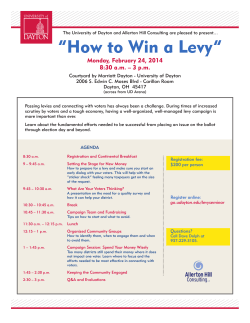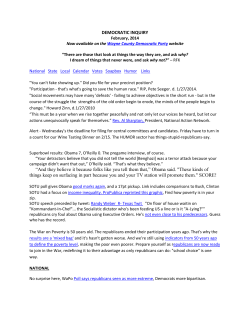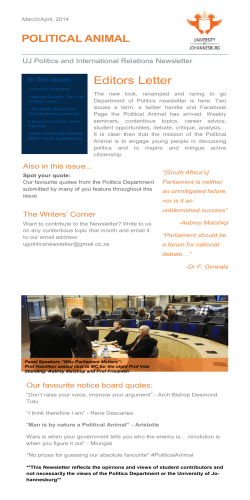
United States Government & Politics AP Sample Multiple-Choice Questions
AP® United States Government & Politics Sample Multiple-Choice Questions The materials included in these files are intended for noncommercial use by AP teachers for course and exam preparation; permission for any other use must be sought from the Advanced Placement Program. Teachers may reproduce them, in whole or in part, in limited quantities, for face-to-face teaching purposes but may not mass distribute the materials, electronically or otherwise. These materials and any copies made of them may not be resold, and the copyright notices must be retained as they appear here. This permission does not apply to any third-party copyrights contained herein. THIS IS NOT A COMPLETE EXAMINATION. Copyright © 2001 by College Entrance Examination Board. All rights reserved. College Board, Advanced Placement Program, AP, and the acorn logo are registered trademarks of the College Entrance Examination Board. Directions: Each of the questions or incomplete statements is followed by five suggested answers. Select the one that best answers the question or completes the statement. 1. In the organization of government, the principle of federalism is best illustrated by the (A) president’s power as commander in chief (B) separation of powers between the Supreme Court and Congress (C) representation system for electing senators (D) qualifications for the office of president (E) federal bureaucracy 2. All of the following contribute to the success of incumbent members of Congress in election campaigns EXCEPT: (A) Incumbents usually raise more campaign funds than do their challengers. (B) Incumbents tend to understand national issues better than do their challengers. (C) Incumbents are usually better known to voters than are their challengers. (D) Incumbents can use staff to perform services for constituents. (E) Incumbents often sit on committees that permit them to serve district interests. 3. The voting patterns of members of Congress correlate most strongly with (A) the population density of their districts (B) their economic background (C) their educational level (D) their political party affiliation (E) the location of their districts 4. The Constitution and its amendments expressly prohibit all of the following EXCEPT (A) slavery (B) double jeopardy (C) cruel and unusual punishment (D) unreasonable searches and seizures (E) sex discrimination in employment AP United States Government & Politics 1 5. In vetoing a bill, the President does which of the following? (A) Rejects only a part of the bill without rejecting it entirely. (B) Prevents any further action on the bill. (C) Sends the bill back to conference committee. (D) Rejects all sections of the bill. (E) Decides the bill’s constitutionality. 6. All of the following are true about the relationship between regulatory agencies and the industries they regulate EXCEPT: (A) Agency employees are often recruited from the regulated industry. (B) Agencies often rely on support from regulated industries in making budget requests before Congress. (C) An agency’s relationship with a regulated industry may change when a new president takes office. (D) Agencies usually make decisions without consulting the regulated industry. (E) Agency employees often are employed by the regulated industry once they leave the agency. 7. The largest source of federal revenue is the (A) capital gains tax (B) Social Security tax (C) property tax (D) income tax (E) sales tax 2 AP United States Government & Politics Republican Party Identification in 1984 8. The chart above supports which of the following conclusions? (A) A majority of the men polled identified with the Republican party. (B) More men than women voted for Ronald Reagan in 1984. (C) The younger a man was, the more likely he was to identify himself as a Democrat. (D) The Geraldine Ferraro vice-presidential candidacy caused many formerly Republican women to identify with the Democrats. (E) The gender gap among those who identified with the Republican party was narrowest for those between 25 and 34 years of age. 9. In Brown v. Board of Education of Topeka, the Supreme Court established which of the following principles? (A) A school official can search a student for drugs. (B) Everyone must go to school at least until the age of 16. (C) Tuition for private schools cannot be tax deductible. (D) Separation of students by race, even in equally good schools, is unconstitutional. (E) A moment of silent prayer at the beginning of the school day is allowable under the First Amendment. AP United States Government & Politics 3 10. Which of the following statements about Democrats and Republicans is true? (A) City dwellers are more likely to call themselves Republicans than Democrats. (B) Republicans are more likely than Democrats to label themselves “conservatives.” (C) Black people are more likely to call themselves Repubicans than Democrats. (D) Republicans are more likely than Democrats to believe that adequate medical care should be guaranteed by the federal government. (E) People in working-class occupations are more likely to call themselves Republicans than Democrats. 11. Of the following groups of eligible voters, which is LEAST likely to vote? (A) The young with low education levels (B) The middle-aged with low education levels (C) Middle-aged and older women (D) Blue-collar workers (E) Middle-class black people 12. All of the following were concerns about the Articles of Confederation that led to the calling of the Constitutional Convention of 1787 EXCEPT (A) dissatisfaction over safeguards of individual rights and liberties (B) fear for the stability of the central government (C) desire to promote trade among the states (D) the need to give the central government the power to levy taxes (E) dissatisfaction with the central government’s ability to provide for national defense 13. A member of the House of Representatives who wishes to be influential in the House itself would most likely seek a place on which of the following committees? (A) Agriculture (B) District of Columbia (C) Public Works and Transportation (D) Rules (E) Veterans’ Affairs 4 AP United States Government & Politics 14. Political parties serve which of the following functions in the United States? I. Informing the public about political issues II. Mobilizing voters and getting them to the polls III. Organizing diverse interests within society IV. Establishing the rules governing financial contributions to political candidates (A) II only (B) I and II only (C) III and IV only (D) I, II, and III only (E) I, III, and IV only 15. The primary election system of selecting presidential candidates has had which of the following effects? (A) It has increased the importance of state party organizations. (B) It has loosened the hold of party leaders over the nomination process. (C) It has reduced the role of citizens in the candidate selection process. (D) It has lowered the cost of running for office. (E) It has led to a decline in the importance of party voterregistration drives. 16. Of the following, which best predicts the likelihood that citizens will vote? (A) Their race (B) Their religion (C) Their educational level (D) Their gender (E) Their region of residence 17. In the United States, which of the following is a rule on voting found in the Constitution or its amendments? (A) No person may be denied the right to vote merely for lack of either state or federal citizenship. (B) No person eighteen years of age or older may be denied the right to vote on account of age. (C) No person may be denied the right to vote merely because he or she has previously served a prison sentence. (D) A state may not establish a residency requirement for voting. (E) A state may require a person to pay a poll tax in order to register to vote. AP United States Government & Politics 5 Questions 18-19 refer to the chart below. Federal Government Growth: Money, Rules, and People, 1948-1978 6 AP United States Government & Politics Refer to the chart on the previous page to answer questions 18 and 19. 18. Which of the following statements about the federal government between 1948 and 1978 is supported by the chart? (A) Federal government spending increased primarily to keep pace with increasing employment. (B) Short-term decreases in the number of federal regulations led to decreases in spending and employment. (C) The bulk of the increase in federal spending resulted from wage increases. (D) A relatively stable number of employees administered larger federal budgets and enforced more regulations. (E) The high cost of regulation prevented the federal government from hiring more workers. 19. Which of the following public policy problems is most likely to result from the situation shown in the chart? (A) Government employees may become responsible for larger bodies of regulation than they can effectively monitor. (B) Regulations may apply to an increasingly small portion of industry as the economy grows. (C) Governmental hiring patterns may draw too many educated workers from the private sector. (D) The influence of special-interest groups may increase as the number of federal employees grows. (E) Increases in the number of federal employees may necessitate the construction of new and expensive federal facilities. 20. Which of the following is argued by James Madison in The Federalist paper number 10? (A) A system of republican representation helps to limit the excesses of factionalism. (B) Small republics are better able to ensure individual liberty than are large republics. (C) The presence of a few large factions helps to protect the rights of minorities. (D) Participatory democracy is the surest way to prevent tyranny. (E) The elimination of the causes of factionalism is the best protection against tyranny. AP United States Government & Politics 7 21. An interest group is most likely to have influence in Congress when the issue at stake (A) is narrow in scope and low in public visibility (B) is part of the President’s legislative package (C) has been dramatized by the media (D) engages legislators’ deeply held convictions (E) divides legislators along party lines 22. Federal spending for which of the following is determined by laws that lie outside the regular budgetary process? (A) Military procurement (B) Regulatory agency funding (C) Government-subsidized housing programs (D) Educational assistance programs such as student loans (E) Entitlement programs such as Social Security Patterns of Group Voting Percent for Reagan — 1980 and 1984 Age 1980 1984 % Change Religion 1980 1984 % Change 18-29 30-44 45-59 60 and over 44% 56% 56% 55% 59% 58% 61% 64% +15% + 2% + 5% + 9% Protestant Catholic Jewish 59% 50% 39% 69% 56% 33% +10% + 6% _ 6% Sex Men Women 57% 47% 62% 58% + 5% + 11% Ethnicity White Black Hispanic 57% 11% 34% 66% 9% 34% + 9% _ 2% — 23. 8 Which of the following can be concluded from the figures in the table above? (A) Catholic and Hispanic voters gave Reagan a lower level of support in 1984 than in 1980. (B) Jewish voters were the only group that did not register gains for Reagan between 1980 and 1984. (C) In terms of support for Reagan, the gap between men and women grew between 1980 and 1984. (D) In terms of support for Reagan, the gap between Black people and White people grew between 1980 and 1984. (E) In terms of support for Reagan, the gap between younger voters and older voters grew between 1980 and 1984. AP United States Government & Politics 24. Of the following, which is the most important reason that voter turnout is lower in the United States than in most other industrial democracies. (A) American citizens are more apathetic than are citizens in other democracies. (B) There are fewer elections in the United States than in other democracies. (C) It has traditionally been more difficult to register to vote in the United States than in most other industrial democracies. (D) United States elections receive less media attention than do elections in other democracies. (E) Unlike other industrial democracies, the United States has a twoparty system. 25. Which of the following is true of a presidential veto of a piece of legislation? (A) It is rarely overridden by Congress. (B) It is not binding unless supported by the cabinet. (C) It can only be sustained on revenue bills. (D) It is automatically reviewed by the Supreme Court. (E) It is subject to approval by a congressional committee. Answers to Multiple-Choice Questions 1–C 6 – D 11– A 16– C 21– A 2–B 7 – D 12– A 17– B 22– E 3–D 8 – E 13– D 18– D 23– D 4–E 9 – D 14– D 19– A 24– C 5 – D 10– B 15– B 20– A 25– A AP United States Government & Politics 9
© Copyright 2026



















